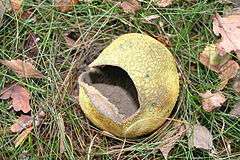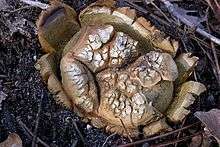Sclerodermataceae
The Sclerodermataceae are a family of fungi in the order Boletales, containing several genera of unusual fungi that little resemble boletes. Taxa, which include species commonly known as the ‘hard-skinned puffballs’, ‘earthballs’, or 'earthstars', are widespread in both temperate and tropical regions.[1] The best known members include the earthball Scleroderma citrinum, the dye fungus Pisolithus tinctorius and the 'prettymouths' of the genus Calostoma.
| Sclerodermataceae | |
|---|---|
 | |
| Scleroderma citrinum | |
| Scientific classification | |
| Kingdom: | |
| Division: | |
| Class: | |
| Order: | |
| Suborder: | |
| Family: | Sclerodermataceae Corda (1842) |
Description
Fruit-bodies are mostly epigenous (above ground), rarely hypogeous (underground), more or less spherical in shape, without a stem or with an irregular root-like stem. The peridium (outer wall) is mostly simple, rarely 2-layered, firm, rarely thin, membranous, breaking open irregularly or in lobes or decaying, revealing the gleba. The gleba typically has sharply defined basidia-bearing sectors, which are partitioned from one another by sterile veins, and in which the basidia are regularly scattered through the tissue. The gleba, which is brown or white in young specimens, turns dark purple to brownish purple in age, and crumbles to a powder of spores and disintegrating tissues at maturity. The basidia are roughly clavate (club-shaped). Spores are brown, roughly spherical in shape, thick-walled, with spines or warts, or with a network-like appearance. Spores are spread by wind, by predators, or are washed into the soil by rainwater.[1][2][3]
Habitat
Taxa are found growing on the ground or associated with rotten wood, and are mostly ectomycorrhizal with woody plants.[1]
Genera
- Calostoma - "prettymouths"
- Chlorogaster [4]
- Favillea
- Horakiella
- Pisolithus - including P. tinctorius (dyemaker's puffball)
- Scleroderma - "earthballs"
The genera Pisolithus, Scleroderma and Calostoma[5][6] are known to be ectomycorrhizal.
Taxonomy
Phylogenetic analysis places the Sclerodermataceae in the bolete clade.[7][8] Older analysis suggests that the Sclerodermataceae (including the genera Scleroderma and Veligaster), the Pisolithaceae (Pisolithus), the Astraeaceae (Astraeus), Calostomataceae (Calostoma), and the new families Gyroporaceae (Gyroporus) and Boletinellaceae (Boletinellus and Phlebopus), should form a new suborder, the Sclerodermatineae.[9]
Gallery

 Scleroderma geaster
Scleroderma geaster Calostoma cinnabarina
Calostoma cinnabarina
| Wikimedia Commons has media related to Sclerodermataceae. |
References
- Cannon PF; Kirk PM. (2007). Fungal Families of the World. Wallingford, UK: CAB International. ISBN 0-85199-827-5.
- Zeller SM. (1949). Keys to the orders, families, and genera of the gasteromycetes. Mycologia 41(1): 36-58.
- Miller, Hope Ridings; Miller, Orson K. (1988). Gasteromycetes: morphological and developmental features, with keys to the orders, families, and genera. Eureka, Calif: Mad River Press. ISBN 0-916422-74-7.
- Laessoe T, Jalink LM. (2004). Chlorogaster dipterocarpi - A new peristomate gasteroid taxon of the Sclerodermataceae. Persoonia 18(3): 421-428.
- Wilson AW; Hobbie EA; Hibbett DS. (2007). "The ectomycorrhizal status of Calostoma cinnabarinum determined using isotopic, molecular, and morphological methods" (PDF). Canadian Journal of Botany. 85 (4): 385–393. doi:10.1139/B07-026.
- Wilson AW; Binder M; Hibbett DS. (2012). "Diversity and evolution of ectomycorrhizal host associations in the Sclerodermatineae (Boletales, Basidiomycota)". New Phytologist. 194 (4): 1079–1095. doi:10.1111/j.1469-8137.2012.04109.x. PMID 22471405.
- Binder M, Hibbett DS, Larsson K-H, Larsson E, Langer E, Langer G. (2005). The phylogenetic distribution of resupinate forms across the major clades of mushroom-forming fungi (Homobasidiomycetes). Systematics and Biodiversity 3(2): 113–157
- Larsson KH; Larsson E; Kõljalg U (September 2004). "High phylogenetic diversity among corticioid homobasidiomycetes". Mycological Research. 108 (Pt 9): 983–1002. doi:10.1017/S0953756204000851. PMID 15506012.
- Binder M, Bresinsky A. (2002). Derivation of a polymorphic lineage of Gasteromycetes from boletoid ancestors. Mycologia 94(1): 85-98.
External links
| Wikispecies has information related to Sclerodermataceae |